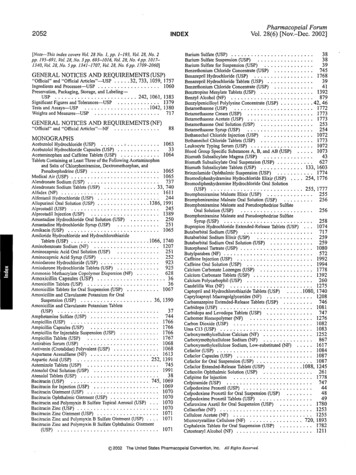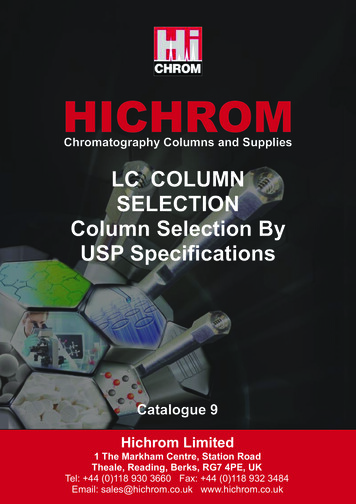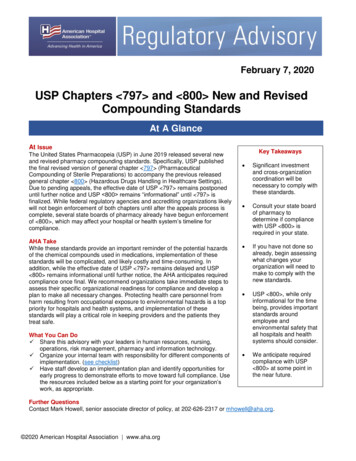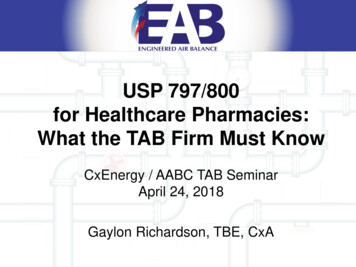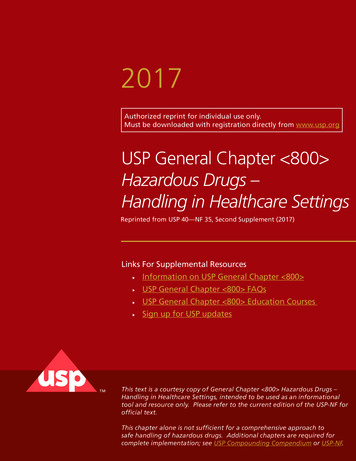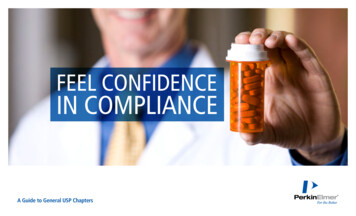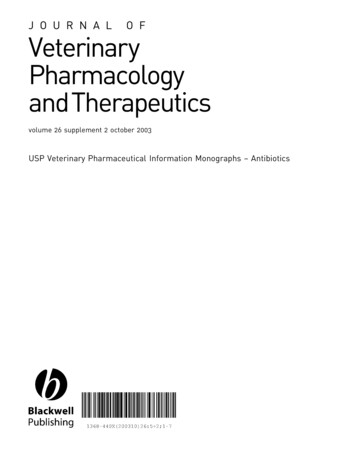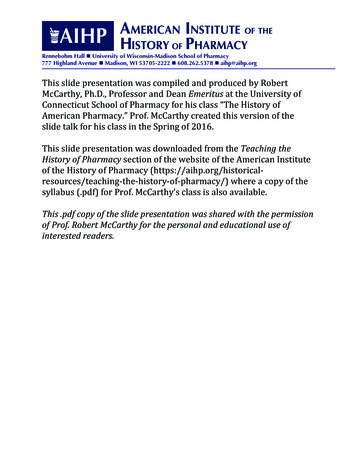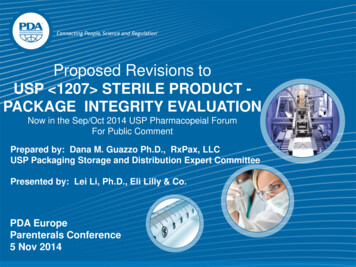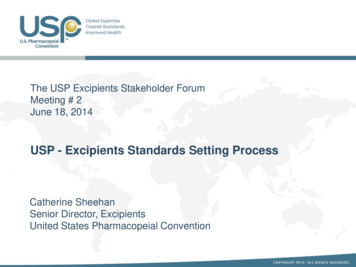
Transcription
USP 797 Compliance in the Laminar Flow WorkstationCabinet Design Attributes and Best PracticesChambre, Andre: CEO, Air Science LLCOctober 2016IntroductionRegulatory compliance procedures abound for the pharmaceutical industry, butperhaps one of the best-known in the compounding side of the industry is USP 797,Sterile Pharmaceutical Compounding Procedures. USP 797 compliance focuses onpractices that prevent harm or death to patients due to microbial contamination,excessive bacterial endotoxins, variability in the intended strength of correctingredients, unintended chemical and physical contaminants, or ingredientsof inappropriate quality.
Andre Chambre, CEO, Air Science, LLC.p:2October, 2016Sterile Pharmaceutical Compounding ProceduresDefinitions of TermsUSP 797 Sterile Pharmaceutical Compounding Procedures1essentially focus on maintaining air quality through the separation of contaminants from compounding materials. In relation toair quality, this typically involves maintaining a Class 5 or better(according to ISO air standards; see Table 1 below) environmentin all critical areas of compounding processes.In order to fully understand USP 797, some critical terms first needidentified and defined:Table 1. ISO Classification of Particulate Matter in Room Air(Limits are in particles of 0.5µm and larger per cubic meter[current ISO] and cubic feet [former Federal Standard No. 209E,FS 209E])*Class NameParticle CountISO ClassU.S. FS 209EISO, m3FS 209E, ft33Class 135.214Class 10352105Class 1003,5201006Class 1,00035,2001,0007Class 10,000352,00010,0008Class 100,0003,520,000100,000*Adapted from former Federal Standard No. 209E, General Services Administration, Washington, DC, 20407 (September 11, 1992) and ISO 14644-1 :1999, Cleanrooms and associated controlled environments—Part 1: Classification of air cleanliness. For example, 3,520 particles of 0.5 µm per m 3 orlarger (ISO Class 5) is equivalent to 100 particles per ft3 (Class 100)(1 m 3 35.2 ft3).Compounding personnel maintain Class 5 sanitation levelsthrough the use of primary engineering controls (PECs), whichinclude laminar flow cabinets (LFCs), biological safety cabinets(BSCs), compounding aseptic isolators (CAIs), and compounding aseptic containment isolators (CACIs). These PECs arecoupled with HEPA filtration to ensure a high level of purification.According to USP 797, one of the most important components ofany compounding sanitation system is the ability to provide “firstair”—the air exiting the HEPA filter in a unidirectional air streamthat is essentially particle-free.11.Compounded Sterile Preparations (CSPs): Anycompounded material containing sterile or nonsterileingredients or components that must be sterilized priorto administration to a patient.2. Critical Site: A location that includes any component orfluid pathway surfaces or openings exposed and at risk ofdirect contact with air, moisture, or touch contamination.3. Direct Compounding Area: A critical area within the ISOClass 5 (see Table 1) primary engineering control (PEC)where critical sites are exposed to unidirectional HEPAfiltered air, also known as first air.4. Primary Engineering Control: A device or room thatprovides an ISO Class 5 (see Table 1) environment for theexposure of critical sites when compounding CSPs. Suchdevices include, but may not be limited to, laminar airflowwork-benches (LAFWs), biological safety cabinets (BSCs),compounding aseptic isolators (CAIs), and compoundingaseptic containment isolators (CACIs).5. Unidirectional Flow: Airflow in a single direction, drawnacross filter media.6. First Air: Air exiting the filter media in a unidirectional flowthat is essentially particle-free.7.Turbulence: flow characterized by erratic or violentmovement.8. Stagnant Air: having no current or flow and containingparticulates as a consequence.“[797] Pharmaceutical Compounding—Sterile Preparations.”Revision Bulletin. The United States PharmacopeialConvention. 2008. Print.Air Science120 6th Street Fort Myers, FL 33907 T/239.489.0024 Toll Free/800.306.0656 F/800.306.0677 www.airscience.com
p:3USP797 Compliance in the Laminar Flow Workstation: Cabinet Design Attributes and Best PracticesTesting ConditionsManufacturers and third-party testing facilities incorporate avariety of initial tests to ensure HEPA filtration in products designedfor pharmaceutical applications conform to industry standardsand certifications. These tests include aerosol challenge testing,particle count testing, airflow uniformity testing and airflowpattern visualization testing.Aerosol Challenge TestingAerosol challenge testing has been used since the mid-1950’sas a means to measure the effectiveness of HEPA filtration andappears in many different standards throughout the world.Individual test conditions can vary, but the general methodinvolves challenging a HEPA filter with a reference aerosol, testingfor initial leaks around the filter frame and gasket, and then measuring the filter media downstream of the filter by using an aerosolphotometer. Commonly referred to as DOP testing, the aerosolphotometry test method is good for measurements to 0.003% andmeets most requirements within the pharmaceutical industry, yetnew technology and instrumentation allows testing of 0.0003% tobe possible.The aerosol photometer uses a near forward scattered lightchamber and a photomultiplier tube as its detection method.The forward scattered light is directly proportional to the aerosolmass concentration, which makes the instrument a continuousreal-time detector and allows an alarm point to be set for easydetection of leaks.The standard requires that the challenge aerosol is used as the100% reference for the downstream measurement and must behomogeneously mixed resulting in an even challenge to the filter.The measurement downstream of the filter is measured as percentage penetration with maximum permissible leaks of 0.01%.Particle Count TestingParticle count testing is another method of aerosol challengetesting that involves a known recorded concentration of aerosol,an aerosol diluter and a discrete particle counter. This method isnewer than DOP testing and uses a discrete particle count (DPC)test method, which is good for measurements to 0.000005% andbetter. This exceeds the requirements for the pharmaceuticalindustry and is really good only for cleanrooms ISO Class 4 andlower because the particle counter is a batch measuring deviceand not designed to make continuous measurements.The particle counter uses a discrete detector measuring the peaklight scattered height of the individual particle passing throughthe detection chamber, and cannot count two particles in thechamber at a time (known as coincidence counting). A diluterhas to be used to measure the upstream aerosol challengebecause of the reliance of this method on a low challenge.Airflow UniformityThe objective of airflow uniformity testing is to meet the criteria setfor airflow velocity and uniformity set in the design specificationsof the unit, which should not be exceeded by more than 15% onaverage. Test methods are relatively straightforward, and involvedividing the environment into a grid, with velocities measured atthe center of each square in the grid by a thermal anemometer,vane-type anemometer, or equivalent. Measurement probesshould be located at a distance of 15 cm or six inches from thefilter face or before the air encounters an obstacle. Readingsat work height are taken for informational purposes only andturbulence induced by non-aerodynamically designed objectsupstream may impede the proper and accurate measurement.Airflow Pattern Visualization (Smoke Testing)Airflow pattern visualization studies (also known as smoke tests)are conducted to confirm unidirectional airflow exiting HEPA andULPA filters, providing visual evidence of airflow direction ratherthan quantitative results. Smoke tests are a useful demonstrationand diagnostic of unit performance. The basic requirements of asmoke test are:1.Airflow moves toward potential sources of contaminationand away from the product path2. Air is flowing in a single direction with no turbulenceor eddies3. Air should regain unidirectional flow quickly from movementwithin the air stream such as attendants manipulatingequipmentThere are minimal equipment and support requirements forperforming a smoke study, which include the fogger, a videocamera, and trained personnel to perform the testing. Adheringto good laboratory processes, personnel will set the fogger up torelease smoke or fog into the unit while the video camera recordsthe results. Various laboratory procedures will be performedwhile the unit is fogged to test the ability of airflow to recover fromdisturbance and the results documented both via video cameraand anecdotal note taking. By observing the patterns of the fogor smoke as it follows the airflow, inferences can be made aboutthe airflow patterns and unidirectional flow provided by the unitduring normal operating procedures.
USP797 Compliance in the Laminar Flow Workstation: Cabinet Design Attributes and Best Practicesp:4IEST TestingOverlap of Standards and TestingThe Institute of Environmental Sciences and Technology developsrecommended practices and testing procedures for the scientificand pharmaceutical communities to meet USP 797 standards2.First air quality standards are certified based on media-fill testingas outlined by USP 797:IEST recommendations directly overlap with USP 797 standardsand incorporate additional safeguards to ensure testing meetsall identified standards. One additional IEST requirement is thatwhen performing velocity testing, airflow velocity test points cannot be placed more than 12 inches apart in order to ensure thatsuch velocity tests take into account any dead spots or areas ofstagnant air. Smoke testing is a fast and effective technique thatcan help identify areas of stagnant or turbulent air in a unit priorto the actual velocity test, allowing personnel to visualize theairflow patterns within the unit and correct any issues caused byproducts or instruments.This test or an equivalent test is performed at least annuallyby each person authorized to compound in a low-risk levelenvironment under conditions that closely simulate themost challenging or stressful conditions encountered duringcompounding of low-risk level CSPs. Once begun, this test iscompleted without interruption.While the media-fill test is utilized to certify air cleanliness andthe capabilities of individual techniques to avoid contamination, this is not typically the main test used to certify PECs. Themedia-fill test is designed to represent the most challenging orstressful conditions encountered by personnel, and when thetest simulates high-risk level compounding, the test can verify thecapability of the compounding environment to produce a sterilepreparation.Typically, filter challenge testing using aerosol and particlecounts are the main tests to perform to certify PECs. The principle of this style of testing involves comparing the number ofparticles penetrating the filter as it is scanned or challenged tothe upstream particle count. The lower the level of downstreamparticles detected, the greater filter efficiency and increasedsafety.2IEST Standards and Recommended Practices: Complyingwith USP 797 Requirements for Cleanrooms and OtherControlled Environments. The Institute of EnvironmentalSciences and Technology (IEST), 2015.Typical Cabinet Design Features to meet USP 797and IEST standardsIn order to meet USP 797 and IEST standards, most cabinetdesigns involve unidirectional flow across HEPA filters. Any disruption in the flow pattern of the air through the cabinet can resultin stagnant or contaminated air being able to come in contactwith critical sites. While there may be a variety of methods toovercome these risks, Air Science laminar flow products incorporate sound design principles to effectively meet USP 797 and IESTtesting standards.
p:5USP797 Compliance in the Laminar Flow Workstation: Cabinet Design Attributes and Best PracticesAir Science Designs that meet USP 797and IEST standardsPurair HLF AirflowWhen used according to best practices, the LF Series cabinetencourages compliance with criteria set forth by USP 797 forsterile preparation in pharmaceutical compounding of nonhazardous agents. These include injectables, IV admixtures, pastesand ointments, and irrigating solutions that are protected by alaminar flow of filtered air over the work surface.The design of the Purair LF series cabinets incorporate severalunique characteristics, such as an ULPA filter pressure gaugeto measure filter performance and all-steel construction withexclusive MICROgone anti-microbial powder finish. Otherdesign attributes are unique to horizontal or vertical laminar floworientations, as follows:Purair Horizontal Laminar Flow (HLF) Horizontal flow cabinets are designed with a lip on the rearof the work surface to protect the ULPA filter from spills. Thisriser does not interfere with unidirectional flow or createturbulence. The design of the HLF provides first air across the entire interiorwidth with a high-capacity air handling system that deliversflow velocity of 0.35-0.45 m/s or 70-90 fpm.Purair Vertical Laminar Flow (VLF) The rear wall is perforated to reduce work surface turbulenceby removing some of the airflow to the rear. The design of the Purair VLF prevents turbulent or stagnantair through the use of negative pressure around and abovethe sides of the filter and filter gasket. Negative pressure pores around the filter frame preventcontamination to the product and do not interfere withfirst air or unidirectional flow from the ULPA filter.Air Science Design EnhancementsAir Science has incorporated a variety of internal designprinciples that help their laminar flow products to specificallycomply with USP 797 and IEST standards. The ULPA filter suppliesparticle-free air in a unidirectional stream to the direct compounding area. Additionally, the Critical Area exceeds ISO Class5 requirements and the air velocity is sufficient to sweep particlesaway from the compounding area.First Airfrom ULPANo “dead”spotsLip guards againstspills and does notcreate turbulenceUnidirectional flowacross entire worksurfaceThe Air Science Horizontal Laminar Flow cabinet provides unidirectionalairflow directly from the ULPA filter across the entire work surface. Cabinetdesign ensures no air dead spots to interfere with first air delivery and a rearlip on the work surface guards against contamination from spills.Purair VLF AirflowNegativepressure/vacuumAirflowFilterMeets IEST because air does notremain turbulent inside the cabinetspace and is returned unidirectionally to the work surface. Negativepressure returns around the sides ofthe filter to prevent stagnant air andcontaminants from impacting thedirect compounding area.In the Air Science Vertical Laminar Flow cabinet, first air contacts thework surface directly as it flows from the ULPA filter. The VLF incorporates aperforated rear panel to combat turbulent or stagnant air in this area of thework zone. Additionally, no stagnant air exists on the ceiling of the unit asperforations in the ceiling panel to the side of the filter gasket help createan area of negative pressure to ensure all air entering the work zone isULPA-filtered first.
p:6USP797 Compliance in the Laminar Flow Workstation: Cabinet Design Attributes and Best PracticesConclusionsAbout the Author: Andre ChambreSignificant design features have been considered to ensure thatairflow and filtration in Air Science cabinets meet the stringentstandards required by the pharmaceutical compoundingcommunity. Air Science laminar flow products sufficiently meetUSP 797 standards when used in accordance with IEST recommended practices.Andy Chambre is the founder and CEO of Air Science, LLC andhas been associated with the ductless fume hood industry formore than 25 years. He was formerly the US Vice President forCaptair Labx and President of Astec Microflow US. He was namedPresident of Filtco Corporation in 2003 and currently also servesas a Director of Air Science Technologies Ltd. in the UK. Mr.Chambre has written numerous articles on fume hood safety andassisted in the development of safety standards by serving onvarious committees such as the Canadian Standards Associationsubcommittee on fume hoods and the SEFA 9 Ductless EnclosuresCommittee.Suggestions for further testingFurther testing on Air Science products could provide conclusiveevidence that would benefit the laboratory products community. Incorporating smoke tests, induction testing, and furthermedia-fill tests on all Purair Laminar Flow models can help toidentify potential sources of turbulence or contamination. WhileAir Science laminar flow products currently meet all stringentcompounding standards, testing protocols and standards maychange over time. However, Air Science is committed to continuing to meet such necessary standards and guidelines in order toensure safety, accuracy, and integrity.Sources “[797] Pharmaceutical Compounding—Sterile Preparations.”Revision Bulletin. The United States PharmacopeialConvention. 2008. Print. IEST Standards and Recommended Practices: Complying withUSP 797 Requirements for Cleanrooms and Other ControlledEnvironments. The Institute of Environmental Sciences andTechnology (IEST), 2015.120 6th Street Fort Myers, FL 33907T/239.489.0024 Toll Free/800.306.0656 F/800.306.0677www.airscience.comAir Science and Purair are registered trademarks of Air Science Corporation. 2016 Air Science OW 10885 10/16
Unidirectional Flow: Airflow in a single direction, drawn across filter media. 6. First Air: Air exiting the filter media in a unidirectional flow that is essentially particle-free. 7. Turbulence: flow characterized by erratic or violent movement. 8. Stagnant Air: having no current or flow and containing particulates as a consequence.


